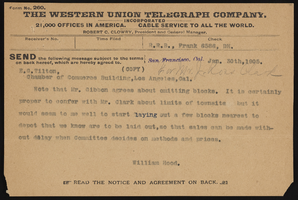Search the Special Collections and Archives Portal
Search Results
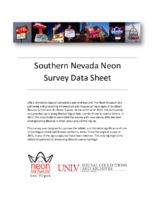
Joker's Wild Casino Neon Survey document, August 20, 2017
Date
Archival Collection
Description
Site address: 920 N Boulder Hwy
Sign owner: Boyd Gaming
Sign details: Opened 1990 as Cattle Baron Casino, closed and reopened at Joker's Wild 1993.
Sign condition: 5 - well maintained sign
Sign form: Super Pylon, and on top of building.
Sign-specific description: Neon Jester's hat on top of the Pylon sign, with a casino sign below and a reader board below that. Large neon Jester's hat on top of the Building. "Jokers Wild Casino" wrapping part of the building also in neon.
Sign - type of display: Neon
Sign - media: Steel
Sign - non-neon treatments: Reader board and LED
Sign animation: Chase with light bulbs around outside of the cabinet that houses the property name.
Sign environment: On Boulder Highway in Henderson surrounded by empty lots and small residential areas.
Sign - date of installation: c. 1993
Sign - thematic influences: The property uses the joker playing card theme. This time is used with several other casino properties throughout the Las Vegas Valley.
Survey - research locations: Boyd Gaming website, assessor's website
Surveyor: Wyatt Currie-Diamond
Survey - date completed: 2017-08-20
Sign keywords: Pylon; Neon; Steel; Chasing; Reader board; Video screen; Porte-cochère
Text
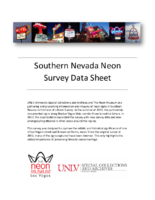
Lucky Cuss Neon Survey document, September 14, 2017
Date
Archival Collection
Description
Site address: 3305 Fremont St
Sign owner: D B N G LLC
Sign details: This property was originally the Panorama Motel, which opened in the 1950's. However, the signage later changed to fit the Lucky Cuss Motel. It was removed from the property in 2008. In 2012, the old sign was restored by the Neon Museum and placed on Las Vegas Boulevard. The replacement sign is still at the property.
Sign condition: 5 - appears to be well maintained
Sign form: Roadside pole
Sign-specific description: The sign at the property is a rectangular cabinet, with the edges at the top rounded off. The background of the cabinet is red, and the outline is blue. The words "Lucky Cuss" are white in a stylized front, and the word "Motel" in larger, block white lettering. On the side of the cabinet is the address 3305.
Sign - type of display: Neon
Sign - media: Steel
Sign environment: Property is on Fremont St, near a car dealership and other motels
Sign - date of installation: c. 2008
Sign - thematic influences: The sign does keep some of the original elements of the first sign, the 1950s era stylized font and simple outlines of neon.
Sign - artistic significance: The sign, although new, does throwback to the original's 1950s creation date.
Survey - research locations: Assessor's website, roadarch.com
Surveyor: Lauren Vaccaro
Survey - date completed: 2017-09-14
Sign keywords: Neon; Steel; Pole sign; Roadside
Text
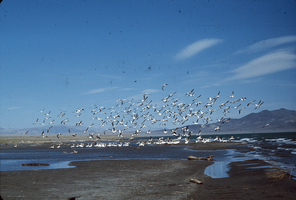
Slide of pelicans at Pyramid Lake, Nevada, circa 1970s
Date
Archival Collection
Description
Image
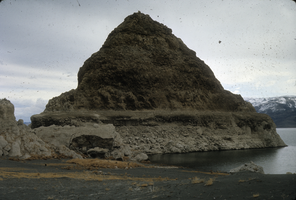
Slide of a tufa deposit in Pyramid Lake, Nevada, circa 1970s
Date
Archival Collection
Description
Image
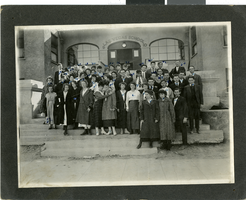
Photograph of students at Las Vegas School, Las Vegas (Nev.), 1916
Date
Archival Collection
Description
Image
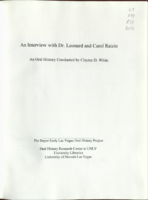
Transcript of interview with Dr. Leonard and Carol Raizen by Claytee D. White, April 8, 2009
Date
Archival Collection
Description
Leonard Raizin was born in Windsor, Ontario, Canada in 1930. His father was a cattle dealer. At an early age Raizin knew he wanted to be a doctor and after attending medical school he married his wife Carol Raizin born in Toronto, Canada. Leonard Raizin attended the University of Toronto for medical school in 1948. He met his wife Carol on a blind date. He started his internship at Sinai Hospital of Detroit in 1954. After a trip to Arizona and a feel of the desert weather the Raizins' with their four young daughters moved to Las Vegas, NV in 1961. When arriving in Las Vegas Dr. Raizin practiced at Southern Nevada Memorial Hospital (currently University Medical Center) and also at Sunrise as an anesthesiologist. There was a time while practicing in Las Vegas Dr. Raizin was the only anesthesiologist in the area, and experienced for the first 6 months of life in Las Vegas an extremely immersed schedule that never allowed him an entire night at home. Carol Raizin graduated as one of the first students at UNLV with a degree in Psychology in 1973. Carol eventually worked alongside her husband in their office handling bookkeeping for eight anesthesiologists. Dr. Leonard Raizin and Carol Raizin after a very successful life in Las Vegas are now retired. They still have a home in the Las Vegas area, however they spend their winters skiing in Park City, Utah and their summers fishing in Idaho.
Text
Ariana Saunders (The Corporation for Supportive Housing) oral history interview conducted by Kelliann Beavers and Elia Del Carmen Solano-Patricio: transcript
Date
Archival Collection
Description
From the Lincy Institute "Perspectives from the COVID-19 Pandemic" Oral History Project (MS-01178) -- Community organization interviews file.
Text

Transcript of interview with Christopher Maestas by Claytee White, September 14, 2008
Date
Archival Collection
Description
Christopher “Chris” Maestas (1965-2009) was an engaged educator and leader within the Chicano, Latinx, and Henderson communities. As he traced back his Latinx heritage, he explored his father’s hometown in Llaves, New Mexico, where he and his family were discriminated for their non-white demeanor; and his mother’s paternal Spanish roots; his grandfather came to work in Henderson, Nevada at the Basic Magnesium Industrial (BMI) plants during World War II. The Chicano and Spanish cultures played a significant part in defining his role within the community. For Chris, Chicanos were “people that lived in the southwestern United States particularly southern Colorado, New Mexico and northern Arizona that were originally Mexican citizens before the treaty (Treaty of Guadalupe Hidalgo) was signed and then after the treaty was signed they became Americans.” In this interview, he dives into the difference between Chicano and Spanish cuisine and gives his own tips on how to make Spanish chile relleno. Chris discussed what life was like in Henderson living in Henderson Camp when his grandfather emigrated from Spain in 1943. He described the evolution of the Henderson community in the 50s through his parents’ experiences living in the Hispanic communities of Victory Village and Carver Park. During his childhood in the early 70s, Chris recalled living in Henderson when it was known as Basic and living in a small town-site house. One of his most special recollections was from the summer of 1980, when his family purchased their first set of air-conditioning units. As a passionate teacher and 1984 alumnus from Basic High School, he advocated student engagement as Student Council Advisor. Chris was also an active member of the St. Peter the Apostle, Catholic Church, Knights of the Columbus group and LUPE (Latinos United for Perfect Equality) Club. The LUPE club promoted equality for the Hispanic community and family values. Chris described their Saturday picnics at BMI Park and the annual Henderson Industrial Days festival.
Text

Transcript of interview with Gerald Gordon by Barbara Tabach, November 02, 2016
Date
Archival Collection
Description
In 1961, at the age of thirteen, Gerald ?Jerry? Gordon became a bar mitzvah. This typical coming of age celebration was unusual in that he had simultaneously studied in both his home state of California and his adopted home of Las Vegas, where he spent summers with his grandparents. 1961 is also the same year that the Gordons made Las Vegas their permanent home. Jerry graduated from Las Vegas High School, attended University of Nevada, Las Vegas and earned his law degree from University of California, Los Angeles. His gregarious and trustworthy personality led him to career building steps in the legal community of Las Vegas that included illustrious names such as Louis Wiener, Jr., David Goldwater, Neil Galatz, and many others. His personal law specialty became bankruptcy, especially dealings with hotel/casinos. As a member of the Jewish community, Jerry?s energy and expertise to organize was instrumental in the construction of Congregation Ner Tamid, the reform synagogue, at its site on Valle Verde and I-215. It was a multi-year process and includes a vast array of stories?a cash donation from Moe Dalitz, finalization of receiving of a donation land from the Greenspun family during the High Holy Days, and the ongoing challenges of a building campaign during a recession. In addition, he explains that CNT included two unique negotiations: 1) a cell tower and 2) a solar field on the synagogue?s property. Jerry and his wife Yvonne met while attending UNLV. Yvonne taught math at various levels in the Clark County School District. They raised their two children, Sara and Jeffrey, in Las Vegas, and forged an important role together in Congregation Ner Tamid. In April 2017, they were among those honored for their work with the synagogue.
Text

